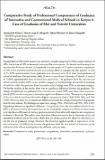| dc.description.abstract | A population of 280 intern doctors was randomly sampled using Gay's (1992) sample estimate of 20%. An increase of 10% in the sample accounted for non-response. The desired random sample size was therefore 84 intern doctors. A purposively selected sample of 47 supervisors from a population of 140, which included medical doctors and nursing officer in charges, was also assessed. A total of 54 (63% questionnaires) from graduates were returned with 26 of these from graduates of school of medicine- Moi university, while 28 were returned from University of Nairobi. A total of 47 (100%) questionnaires were returned from supervisors. The graduates from the conventional school rated themselves 82% on the excellent category in the knowledge of scientific foundation of medicine while the graduates from innovative school ratings were 89% on the same category. On further analysis of the results, there was no significant difference between the graduates. The ratings of supervisors on graduates from conventional school (56%) and those from innovative school (53%) on this competence showed no significant difference either. The majority of graduates of the two schools considered themselves highly competent in clinical skills (76% IMS; and 79% CMS). However, there was no significant difference between the ratings of proportion of graduates from the two schools. The findings on supervisors ratings (70%, 30% IMS; and 70%, 30% CMS) of graduates showed no significant difference. The graduates from the two medical schools do not differ at all as perceived by their supervisors on the seven global competences. However, there seems to be significant differences in the way graduates perceive themselves with regard to six competences as shown in the study. The author notes that these differences may be due to limitation of the self assessment method used in the study, which does not always provide for objective information as was the case in graduates' ratings. However, this limitation applied equally to respondents of the two universities, the differences between the graduates from the two schools of medicine can be indicative of the effects resulting from the different curricula used. | en_US |

